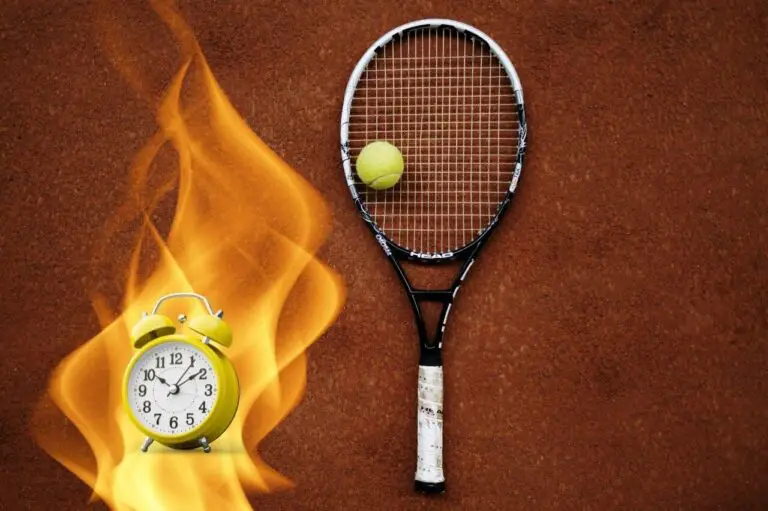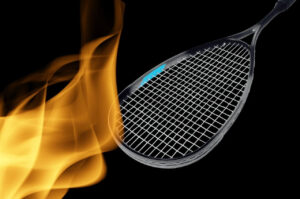How long should I expect my tennis racket to last? This is a question that many people ask, and it can be difficult to give a definitive answer.
Tennis rackets are not all created equal, and how you use your racket will also affect its lifespan.
In this guide, we will discuss the different factors that play into how long your tennis racket will last.
We will also provide tips on making your racket last longer.
Let’s start with the big question – How long should a tennis racket last?
So how long should a tennis racket last?
The answer to this question depends on a few different factors, including how often you play tennis, how hard you hit the ball, and how well you take care of your racket.
Generally speaking, most people can expect their racket to last for several years. However, if you are an avid player who hits the ball very hard, you may need to replace your racket more frequently.
Ultimately, Rackets last approximately one year for a power hitter and lose stiffness after that.
Rackets can survive 10 years or more in the hands of a club player who doesn’t hit the ball particularly hard and cares for them.
Would you like to know how can you make your tennis racket last longer?
Continue to read, we have some tips for you…

How can you make your tennis racket last longer?
There are a few things you can do to make your tennis racket last longer:
1. Use a racket cover when you are not using your racket. This will protect it from dirt and debris.
2. Store your racket in a cool, dry place. Avoid storing it in direct sunlight or a humid environment.
3. Don’t leave your racket in the car. Extreme temperatures can damage the racket.
4. Restring your racket regularly. This will help keep the strings from breaking and prevent them from becoming frayed.
5. Inspect your racket regularly for any signs of wear or damage. If you notice any issues, take your racket to a professional for repairs.
following these tips will help ensure that your racket lasts for many years to come.
Let’s talk about restrung your tennis racket...
How do you know if your tennis racket needs to be restrung?
When your strings begin to fray or appear shaggy, or they’re about to break apart and you won’t be able to generate as much spin or power when you hit the ball, it’s time to restring them.
How often does a tennis racket need to be restrung?
How often you need to restring your racket depends on the type of strings you use.
If you use polyester strings, you should restring your racket every 10 to 15 hours of play.
If you use nylon or multi-fiber strings, you can add a couple more hours to that.
Ultimately, it’s best to consult with a professional to get an accurate estimate of how often you should restring your racket.
What happens if I don’t restring my tennis racket?
If you don’t restring your racket, the strings will eventually break.
This can cause damage to the racket and may even injure you if the string breaks while you are hitting the ball.
It’s also important to note that if you don’t restring your racket, you will lose tension in the strings. This can result in a loss of power and spin when you hit the ball.
If you don’t restring often enough, you’ll most likely spend the majority of your tennis life compensating for changing string tension rather than fine-tuning your swing.
What about your racquet stiffness, let’s check out if racquets lose stiffness over time?…in the next question…
Do racquets lose stiffness over time?
All racquets lose stiffness over time. Even if you don’t use your racket, the frame will gradually become weaker and less stiff.
However, how quickly a racket loses stiffness depends on several factors, including the type of material the racket is made of and how well it is taken care of.
When that happens, and your racket frame loses stiffness and feels soft, you will lose power and control over your racket.
Finally, we would like to leave some space and honor the old rackets… stay with us to the next two last questions…
Are old tennis rackets still good?
This is a difficult question to answer. It depends on the racket, how it was made, and how it has been used and stored over the years.
If you have an old tennis racket that you have not used in many years, it is probably best to get a new one. The strings on your old racket may be rotten, and the racket itself may have lost some of its stiffness. This will make it much harder to play with.
However, if you have an old tennis racket that you have been using regularly, it is probably still fine. The strings may need to be replaced, but the racket itself should be fine.
Some of the old racquets are good, while others aren’t.
Racquets that are 20-30 years old function well today.
There are racquets on the market today that play better than most vintage racquets did.
It doesn’t matter what kind of racket you have; it’s a decent one if it works for you.
Are old tennis rackets valuable?
Some old tennis rackets can be quite valuable, especially if they are signed by a famous player.
Racquets that are 20-30 years old can be worth quite a bit of money, depending on the make and model.
If you have an old racket that is in good condition, it might be worth getting it appraised.
In conclusion:
How long a tennis racket will last depends on several factors, including how often you play, how hard you hit the ball, and how well you take care of your racket.
Most people can expect their racket to last for several years. However, if you are an avid player who hits the ball very hard, you may need to replace your racket more frequently.
There are a few things you can do to make your tennis racket last longer, such as using a racket cover and storing your racket in a cool, dry place.
You should also restring your racket regularly to prevent the strings from breaking and fraying. Inspect your racket regularly for any signs of wear and tear.
If you notice any damage, take your racket to a professional for repairs.
By following these tips, you can ensure that your racket lasts for many years to come.
I hope this article helped you learn about how long should you expect your tennis racket to last?
If you have any further questions, please feel free to leave a comment below. 🙂
And don’t forget to check out my other blog posts for more informative guides.
Thanks for reading and I will see you on the tennis court! 🙂








